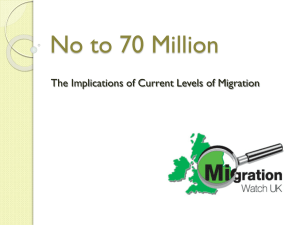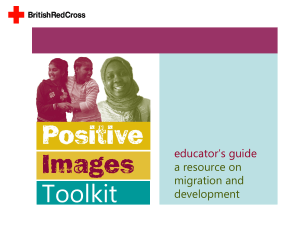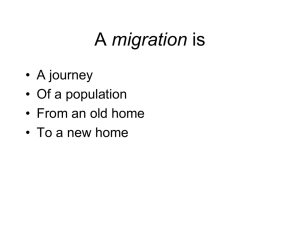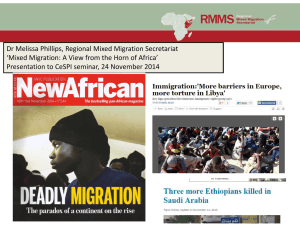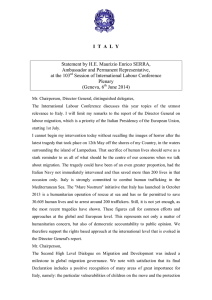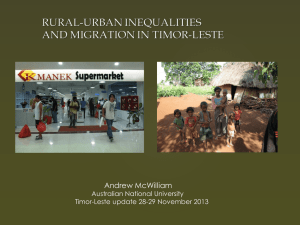(ACP Observatory): Migration and the MDGs from a
advertisement
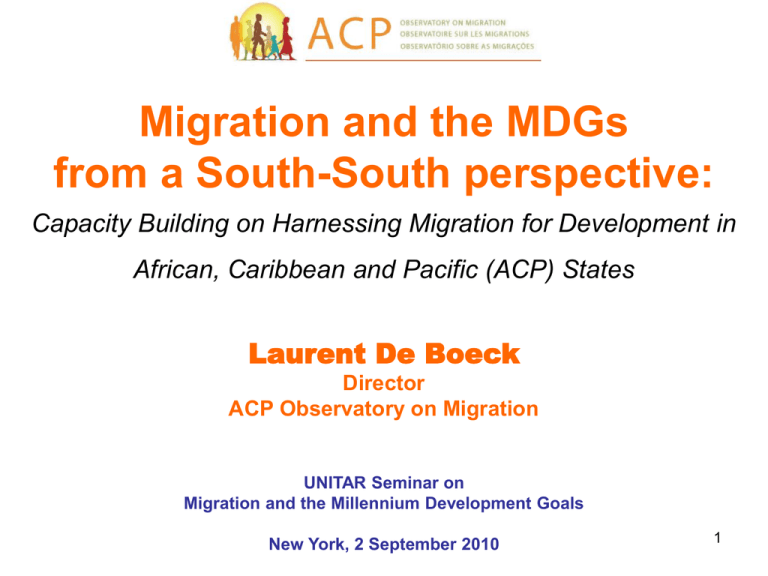
Migration and the MDGs from a South-South perspective: Capacity Building on Harnessing Migration for Development in African, Caribbean and Pacific (ACP) States Laurent De Boeck Director ACP Observatory on Migration UNITAR Seminar on Migration and the Millennium Development Goals New York, 2 September 2010 1 Overview 1. Presentation of the ACP Observatory on Migration 2. The migration - development nexus 3. Contribution of the ACP Observatory on Migration to the MDGs 2 Observatory Rationale Address three main challenges linked to South-South migration research: Data gaps Lack of cooperation between researchers and policy-makers Lack of research capacity 3 Objectives and Goals Establish a network of research centres, universities, government agencies, civil society, media and the private sector in the six ACP regions Consolidate existing migration data and respond to research and policy needs Provide policy-makers, the civil society, media and the public at large with reliable and harmonized data migration Train and capacity reinforcement of multi-disciplinary South specialists and experts 4 12 Pilot Countries East Africa Central Africa Kenya Tanzania West Africa Cameroun Pacific DRC Senegal Nigeria Southern Africa Papua New Guinea Caribbean Timor-Leste Angola Lesotho Trinidad & Tobago Haiti 5 The Migration-Development Nexus Trends in Migration & Development thinking have changed in recent years Before 2000, views mainly emphasized root causes and brain drain Currently concentration is on positive potential of transnational migration, remittances and diaspora The 2010 UN Secretary General Report on MDGs qualified migration as an ‘emerging issue’ There are numerous links between migration and development: the potential of migration to support the realization of the MDGs in Southern countries such as the ACP States should be acknowledged more widely. 6 ACP and South-South Migration Estimated number of international migrants in 2010: • World: 214 million • Africa: 19.3 million • Caribbean: 1.4 million • Pacific: 0,1 million (Source: United Nations, Department of Economic and Social Affairs, Population Division, International Migration 2009) South-South Migration data: In 2007, almost 50 per cent of migrants from developing countries resided in developing countries Almost 70 per cent of emigration from Sub-Saharan Africa concerned South-South movements in 2005 In 2007, over 80 percent of South-South migration was estimated to take place between countries with contiguous borders (Source: D. Ratha, W. Shaw, South-South Migration and Remittances, World Bank, 2007) 7 Migration in the Development Agendas There is growing recognition of developmentmigration links But Lack of integration of migration issues into development agendas has caused inconsistencies and incoherence in national policies and priorities 8 Millenium Development Goals Guiding principles of countries seeking to eradicate poverty and improve the welfare of people 1: Eradicate poverty and hunger; 2: Achieve universal primary education; 3: Promote gender equality and empower women; Used as a strategic framework of reference by international development agencies 4: Reduce child mortality; Are unprecedented in their scope 7: Ensure environmental sustainability; 5: Improve maternal health; 6: Combat HIVAIDS, malaria and other diseases; 8: Develop a global partnership for development. 9 Goal 1 - Eradicate Extreme Poverty and Hunger Poverty reduction by realizing the human right to a decent standard of living through remittances « Social Capital » transfer implication of the diaspora and greater Better management of migration flows can contribute to giving access to water and food to populations who are deprived of them Better management of labour mobility and policy responses to facilitate remittances flows can contribute to development 10 Goal 2 - Achieve Universal Primary Education Migration tends to impact positively on the expenditures for education in households Movement of population can contribute to bringing education to children who do not have access to it (UNDP, 2009) Greater importance must be given to social impact of migration in order to seize the impact of migration on school enrolment (ippr, 2010) 11 Goal 3 - Promote Gender Equality and Empower Women Percentatge of female migrants in the World: 49 (UNDESA 2010) Migration is an empowering experience for many women (Susan Martin, 2007) Migrant’s exposure to different norms regarding women’s rights in the destination country can allow them to develop new attitudes toward gender roles (IPPR, 2010) More and more women are members of diaspora associations and contribute to the development of the country of origin (e.g. Migrant Women for Development in Africa, IOM, 2010) 12 Goals 4 & 5 - Reduce Child Mortality and Improve Maternal Health Remittances used in healthcare services and to develop and improve health systems infrastructure (e.g. Ethiopia; IOM, 2010) Migration contributes to better education and knowledge on health care issues (IOM, 2010) Social outcomes of migration can induce a change in gender and power relations, improving access to healthcare and education for women and children, and the feminization of migration can also include changes in reproductive behaviour (IOM, 2010) 13 Goal 6 - Combat HIV/AIDS The conditions in which the migration process takes place are a cause of migrants’ vulnerability (WHO, 2010) Policies reducing risks for migrants can contribute to a decline in the spreading of HIV/AIDS Greater access to health systems for migrants in countries of destination can contribute to reducing the spreading and social impact of HIV/AIDS 14 Goal 7 - Ensure Environmental Sustainability Migration can alleviate pressure on natural resources in environmentally vulnerable areas (IOM, 2005) Migration can be a possible adaptation strategy of communities vulnerable to effects of environmental degradation (IOM, 2010) Migrants can use the savings and skills they have acquired to address environmental degradation in their homeland (IOM, 2009) 15 Goal 8 - Develop a Global Partnership for Development Development of partnerships is harnessing migration for development essential for Diasporas can play a major role in development and ensuring knowledge and technology transfer Cooperation to develop more accessible formal channels for remittances transfers and trade linkages can increase the impact of migration on development 16 CONCLUSIONS The ACP Observatory on Migration will contribute to the attainment of these goals by: • Producing and disseminating research findings • Creating a network of ACP migration and development experts • Strenghtening South-South cooperation • Capacity-building 17 KEY MESSAGES There are clear positive links between migration and the MDGs Migration should be a consideration in development frameworks aiming to achieve the MDGs More exploration, indicators and research are required on the impact of migration on development Mainstreaming of research and policies on SouthSouth migration should be included in national and international agendas 18 Thank you Contact: mrfbrusselsacp@iom.int 19




